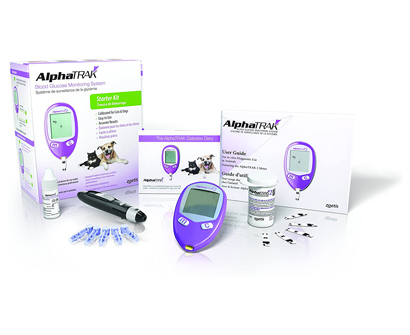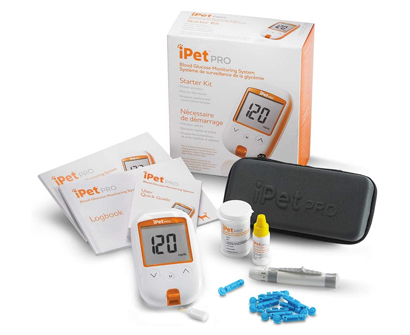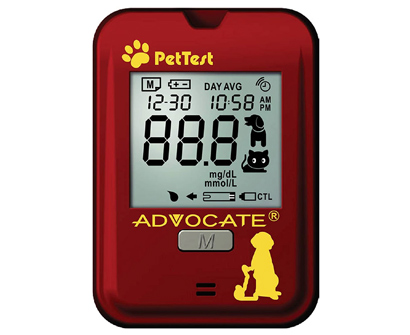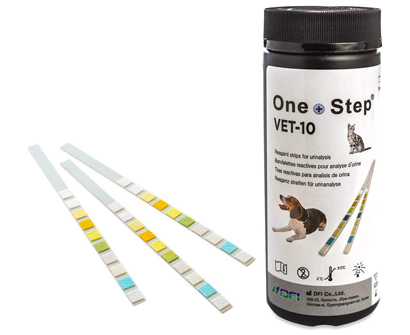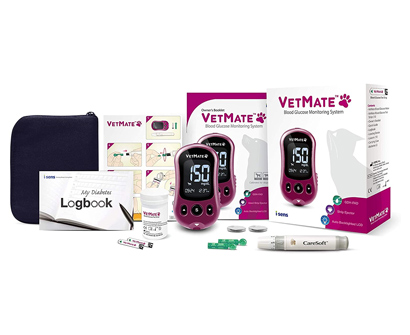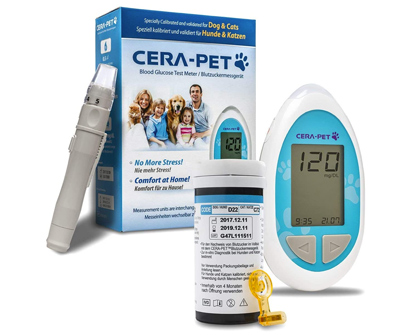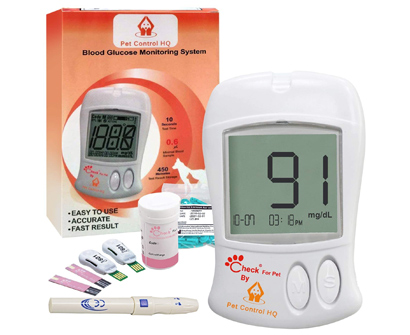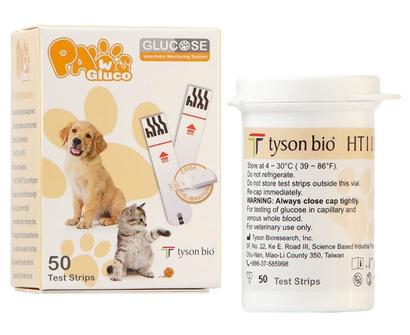The Best Glucose Monitors For Dogs in 2022

- Best Glucose Monitors For Dogs
- 1. AlphaTRAK 2 Blood Glucose Dog Monitoring System Kit
- 2. iPet PRO Blood Glucose Monitoring System for Dogs
- 3. Advocate Pet Test Blood Glucose Monitoring System for Dogs
- 4. One Step 1 x Vet pH Urine Test Strips for Dogs
- 5. VetMate Dogs Diabetes Management STARTER KIT
- 6. Cera-Pet Blood Glucose Monitor for Dogs
- 7. Pet Control HQ Glucometer for Dogs
- 8. EverPaw Gluco HT111 Blood Glucose Diabetes Monitoring System for Dogs
Unfortunately, it isn't just humans that get diabetes - cats and dogs are prone to this disease too. Overfeeding can cause diabetes in dogs and more and more cases are being discovered each day by veterinary professionals. Once your dog has been diagnosed with diabetes, the veterinarian may suggest that you monitor your pet's glucose levels at home. There are lots of different glucose monitoring kits for dogs available online and we have found the best and presented them in this review.
Keep reading to find out which dog diabetes test kit is our number one favorite...
Best Glucose Monitors For Dogs
1. AlphaTRAK 2 Blood Glucose Dog Monitoring System Kit
Key Features
Specially designed for cats & dogs
Only requires a small blood sample
Provides accurate results
Easy to use
This pet glucose meter has been specially designed and calibrated to be used on cats and dogs and analyzes your pet’s glucose levels with a tiny drop of blood. This kit is easy to use and provides a convenient way to monitor your dog’s diabetes from the comfort of your home. Read our guide and FAQs to find out what the best testing site is for your pet dog.
2. iPet PRO Blood Glucose Monitoring System for Dogs
Key Features
Glucose meter
25 x test strips included
Glucose chip & lancing device
28-Gauge lancets
Stores up to 500 tests
Carry case
User guide & logbook
This test kit provides everything you need to monitor your dog’s glucose levels. Inside this kit, you’ll find testing strips, a lance device, meter, control solution, and gauge lancets. We like that it comes in its own case too so you can keep everything together in one handy place. Promising a high level of accuracy, the iPet PRO Kit provides results in around 5 seconds, and as well as being fast and accurate it’s simple to use.
3. Advocate Pet Test Blood Glucose Monitoring System for Dogs
Key Features
Easy to use
Test results in 5 seconds
25 x test trips included
400 test memory
AA batteries included
Carry case
User guide
Another system that has been specifically designed for the monitoring of blood sugar in dogs and cats, this little device provides accurate and fast results that are simple to obtain. You won’t need big samples to gain results either as this glucometer for dogs only requires 0.3mcl of blood to give an accurate result within around 5 seconds. It can store up to 400 test results so you can log the progress of your dog’s glucose levels over a period of time and there’s also a special switch so you can use this for dogs and cats.
4. One Step 1 x Vet pH Urine Test Strips for Dogs
Key Features
Veterinary urine test
50 x strips per tube
Can detect: protein, glucose, PH, ketone and more
Easy to use
If taking blood from your pet isn’t possible, it may have been advised by your veterinarian to take glucose tests through the use of strips. This kit includes 50 x test trips and by dipping the PH strips into a sample of your dog or cat’s urine, you will be able to detect protein, ketone, glucose, and more.
5. VetMate Dogs Diabetes Management STARTER KIT
Key Features
Simple to use
Negative LCD screen for clearer readings
Full starter kit with testing strips, lancets, lancing device, batteries and more
Strip ejector for fast and hygienic removal of used test strips
Once you have been given the all-clear to test your dog’s blood glucose levels then the best thing to begin the process is to buy an easy-to-use starter kit such as this. In this kit, you will find everything that you need to test your dog’s blood glucose levels and monitor their diabetes. The machine has been specially calibrated for pets and provides fast and accurate results. You won’t need to use special code chips, so it’s simple to use and has a clear LCD screen to display the results.
6. Cera-Pet Blood Glucose Monitor for Dogs
Key Features
Highly accurate results
Stores up to 1000 test results
Adaptable lancing device with 5 x comfort settings
Easy-to-follow instructions included
25 x testing strips included
Carry case, 1 x 3V battery, 2 x code keys included
When it comes to glucose monitors, it’s important to get highly accurate results, after all, this is your pet’s health that you are monitoring. This starter kit might not be the easiest on our list but it certainly is one of the most accurate and can store up to 1000 test results which is a fantastic feature for comparing your pet’s health over a period of time. What we like about this kit is that the lancing device is fully adaptable, which means that you can adjust the settings to find the most comfortable solution for your dog.
7. Pet Control HQ Glucometer for Dogs
Key Features
Highly accurate results every time
User manual & logbook
50 x test strips
Carry case, 50 lancets, control solution, lancing device and more
Another kit providing highly accurate results to test your pet’s blood sugar levels. This kit is suitable for use with cats and dogs and contains different testing strips to be used with each animal. Some monitors require a few tests before they display an accurate result but with this dog glucose meter, you will only need to test once. This system has also been specially designed to be gentle on your cat or dog, which means that it won’t cause them any unnecessary discomfort.
8. EverPaw Gluco HT111 Blood Glucose Diabetes Monitoring System for Dogs
Designed to be used on cats, dogs, and horses, the EverPaw monitor requires a small blood sample for the best and fastest results. When you purchase this testing kit you also get full support from the company’s dedicated specialists who work 24/7 to assist you.
Best Glucose Monitor for Dogs Buying Guide & FAQ
Below we answer your most commonly asked questions and offer guidance regarding the best monitors to buy and why you need one if you have a pet with diabetes.
Why You Need to Use a Pet Blood Glucose Meter
It's the same for humans as it is for animals - when diabetes is diagnosed the only way to stay safe, is to closely monitor the condition. The best way to monitor diabetes is to use special monitors that check the glucose levels in your dog's blood. Pet monitors deliver accurate results. It isn't advisable to use human blood glucose monitors as they may provide inaccurate results. Pet specific glucose monitors have been specially calibrated for pet plasma, so never be tempted to use your own.
Check out our guides on Probiotics for Dogs and Dog First Aid Kits.

What to Look for in a Glucose Monitor for Dogs
When looking at glucose monitors for your pet dog it might be tempting to go for the cheapest option - don't ever do this! Look for a reputable brand that has been backed by veterinarians and other professionals in the industry. Starter kits provide a good option for beginners as they contain everything you need to start monitoring your dog's blood sugar levels. Take a look at the kits which provide easy-to-read screens and can store a decent amount of test results too - it's always good to be able to look and see how your pet's blood levels have changed. Accuracy is the most important feature of blood glucose monitors. Find the most accurate testing kit on the market for the best results.
How to Test Your Dog's Blood Glucose & Ketones
There are a few different ways that you can test your dog's glucose levels and ketones. You can use blood glucose monitors which require a small sample of blood taken from an area on your dog, or you can use urine testing strips. With both of these methods, it is absolutely essential that you speak to your veterinarian for advice as each animal is unique and their needs can differ greatly. Some veterinarians require urine samples to be taken, whereas others will need you to take small blood samples. In both cases, they will show you how to do this, what to look out for, and how best to record the data.
Head over to our reviews of Dog Thermometers and Dog Vitamins.
Our Top Pick
Our favorite blood glucose monitor was the AlphaTRAK 2 Blood Glucose Monitoring System Kit which has been specially designed and calibrated to be used on cats and dogs and only requires a small drop of blood. It's easy to use and comes with an instructional user guide.

FAQ
Q: Can I use a human glucose meter on a dog?
This question is always found in pet forums - and to some degree, it makes sense to use human blood glucose monitors on your pets. Blood glucose levels are tested in similar ways for both humans and some animals, such as cats. But this doesn't mean that the same monitors used will deliver the same results. The reason why human blood glucose monitors and animal monitors differ is that the balance of glucose found in human bodies and animal bodies differs greatly. Glucose monitors need to be specifically calibrated for use with a cat or dog (even the animal species differ) or you will get inaccurate results.
Q: What should a dog's glucose level be?
It is vital to regularly monitor your dog's glucose levels if they have diabetes - but it isn't just about monitoring, it's about understanding the results. A healthy dog should have around 100–250 mg/dL but this can differ throughout the day, diabetic dogs will have different glucose levels - usually around 90-216 mg/dl in a 24 hour period. There are many factors that can affect blood glucose levels and these include: stress, weight gain or weight loss, a change in an exercise regime, medication, disease (other than diabetes), and progesterone. Your veterinarian should be made aware of any changes in diet/exercise if you have a diabetic pet. Take a look at our review of the best food for diabetic dogs.
Q: Where is the best place to take blood from a dog?
Collecting a blood sample from your pet can be a scary experience as you understandably don't want to cause your four-legged friend any discomfort. You should speak to your veterinarian before you take any samples and share any concerns that you may have. They will be able to talk you through the process and show you how to take a sample, quickly and without causing any stress or discomfort to your dog. The best places to take samples are usually inside the ear and the pisiform pad (the pad at the back which dogs do not walk on). Older dogs may have hairless calluses on their elbows - this is the perfect spot to take samples as it's practically painless!
Sources
- Diabetes - Veterinary Health Center University of Missouri

